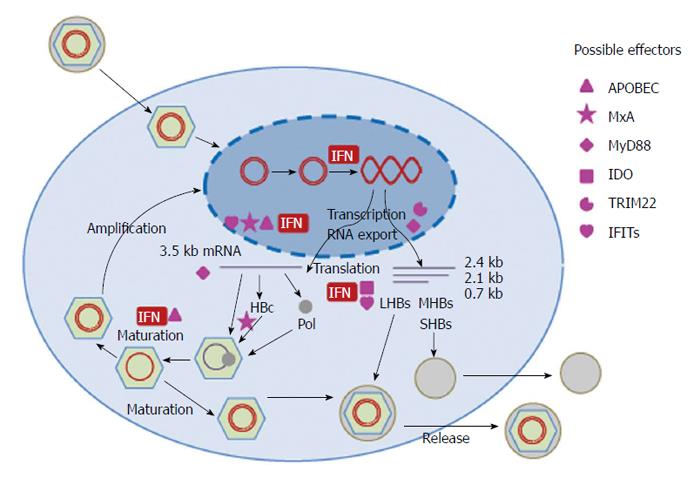Copyright
©2014 Baishideng Publishing Group Inc.
World J Gastroenterol. Sep 7, 2014; 20(33): 11618-11629
Published online Sep 7, 2014. doi: 10.3748/wjg.v20.i33.11618
Published online Sep 7, 2014. doi: 10.3748/wjg.v20.i33.11618
Figure 1 Hepatitis B virus life cycle and the control of hepatitis B virus replication by interferons and interferon stimulated genes.
The hepatitis B virus (HBV) life cycle is described in detail in the section 2. The figure summarizes the mechanisms underlying the interferon (IFN)-mediated anti-HBV actions. IFNs have been reported to target multiple steps of HBV life cycle including the epigenetic modification of cccDNA minichromosomes, the enhancer or promoter activity, the RNA stability, and the nucleocapsid formation. Several IFN-stimulated genes (ISGs) represent the effector molecules downstream of IFN signaling: Apolipoprotein B mRNA editing enzyme (APOBEC) family members interfere with HBV capsid formation and maturation and regulate HBV promoter and enhancer activity; MxA affects the HBV RNA export and capsid formation; myeloid differentiation primary response protein 88 (MyD88) was reported to reduce HBV RNA export and the stability of pgRNA; indoleamine 2,3-dioxygenase (IDO) suppresses HBV translation; tripartite motif-containing protein 22 (TRIM22) was reported to control HBV core promoter activity; IFN-induced proteins with tetratricopeptide repeats 1 and 2 (IFITs) limit HBV replication at the transcriptional and posttranscriptional levels.
- Citation: Pei RJ, Chen XW, Lu MJ. Control of hepatitis B virus replication by interferons and Toll-like receptor signaling pathways. World J Gastroenterol 2014; 20(33): 11618-11629
- URL: https://www.wjgnet.com/1007-9327/full/v20/i33/11618.htm
- DOI: https://dx.doi.org/10.3748/wjg.v20.i33.11618









